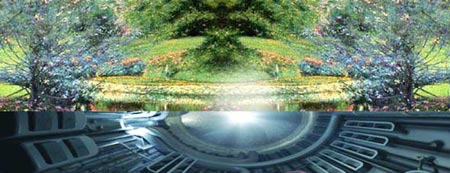BY LETTER
Seedtech
Culture and Society > Cultural Factors > Interstellar Colonization
Technology > Application > Manufacturing
Technology > Application > Spore Technology
Technology > Application > Manufacturing
Technology > Application > Spore Technology
 Image from Bernd Helfert |
An interstellar probe using seedtech will carry with it enough raw materials to become established, until suitable raw materials can be found. Generally seedtech probes also have advanced prospecting technology, which allows the seed to actively seek suitable resources. Sporetech on the other had, relies on large numbers of spores spread throughout a system, only a few of which will find perfect conditions with readily available resources.
Management of seedtech or sporetech devices is generally considered a form of agriculture rather than a form of manufacturing, but in fact the two categories overlap. Nanotech "seeds" may be drytech nano or bionano based, or a combination of the two, and where biological materials are involved may include gengineered or domesticated organisms as well. From the basic seed or spore, a structure can grow on site, gather available materials using roots or mycelium-like structures to harvest the elements they require from the substrate, and local liquids or gases, and growing leaf-like or wind or water mill like collect available natural energy sources if it does not simply tap into a local power grid.
In some cases the device is mobile, or served by mobile sub-units. This self-assembling manufacturing structure then produces the required item or substance, on a one-time basis, or for a pre-programmed period, or indefinitely. Such seeds need to be tailored exactly to particular environments to function properly and safely, and may require management, especially if an entire "farm" of such devices is used. Small home or community use seed nanotech is subject to a wide range of local bylaws, especially in dense settlements, to prevent damage to the habitat and disputes between neighbours.
The larger-scale industrial-grade "seed" nanotech devices with self-replicating ability are nowadays almost always designed and deployed by transapient entities, to prevent mistakes. In the past, entire planetary surfaces have been seriously damaged by runaway self-replicating processes. In civilized regions even the use of seedtech by transapient entities is subject to the supervision of their toposophic peers and superiors.
Related Articles
- Caretaker Seed
- Nanoseed - Text by M. Alan Kazlev
Nanotech "seed", a self-contained and sealed capsule containing assemblers and replicators either pre-programmed with templates or instructed from an external source. The seed is "planted" on a substrate, and activated with energy or a nutrient spray. It then grows into the desired product, using locally acquired resources and ambient energy (e.g. sunlight) or in the case of some large nanoseeds, a small amat battery. - Phototropic Seeds
- Pyrenian Klarion Explorer Seedship
- Warseed - Text by M. Alan Kazlev
Interplanetary Age proto-warchive developed by theThe Cult of the Exsanguinated Giraffe.
Appears in Topics
Development Notes
Text by Stephen Inniss, Steve Bowers and M. Alan Kazlev
Initially published on 02 June 2009.
Initially published on 02 June 2009.






